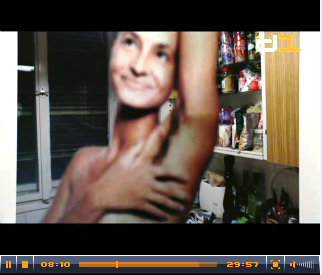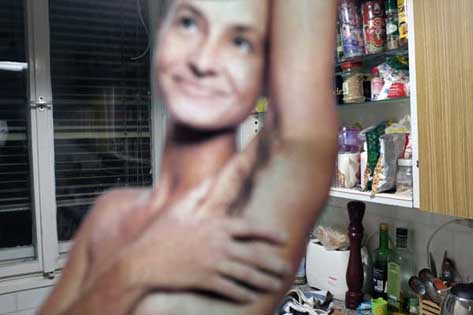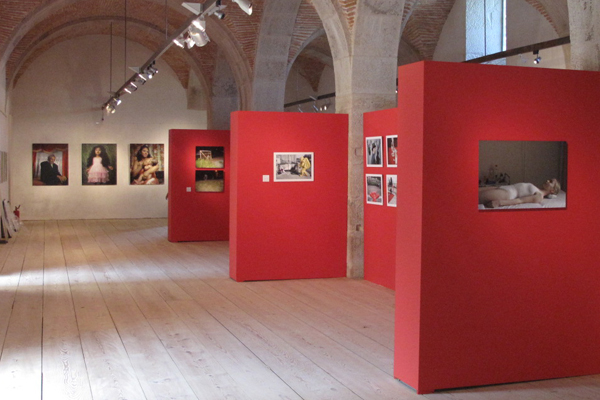
Month: January 2012
Edited dialog between Gabriella Csizek and Gábor Pfisztner
An edited dialog of email exchanges between Gabriella Csizek and Gábor Pfisztner about Krisztina Erdei’s series Nut alley, a series that has not been the object of much public discussion.
G.Cs.: How would you begin to define the intensity and crisp energy of Kriszta Erdei?
G.P.: It is rather difficult. The photos are fairly unequivocal. They don’t want to be anything else than what they are. She does not want to imply or refer to anything or anybody. She is not keeping secrets. Yet, most of the photos entail what Roland Barthes calls photographic shock: the rarity, the invisible to the eye, the photographic take on what’s found or happens unexpectedly.
G.Cs.: What makes it so difficult to define the photos? Is it because they are, in fact, unequivocal and don’t hold secrets? Is it, perhaps, difficult to talk or think about something that is identical with itself? That does not hide behind anything else? That makes declarations about what it actually shows and not what it may suggest? This makes Kriszta’s photos very important and likeable for me, since they discuss the world in such a clear way. She condenses her perception of the world into focused expressions of supposed private photos. Concerning their content and technique, the details are in unity in both the applied technique and the final photo. This is what makes her (and her photos) genuine.
G.P.: Yet, none of this seems coerced as the photos themselves protest with their awkward, clumsy, silly appearance of a snapshot. This, at the same time, however, is intimidating as it is the actual “making” of this “unsophisticatedness” that holds the biggest challenge and task to this kind of photography.
Cs.G.: The question is: why? Why does she take photos like this? What does this mean?
G.P.: It means that we can see the exact, deliberate crop, the composition itself; however, all that is within that composition seems to have only appeared in the spur of the moment. As if she was compelled to take these shots by the joy of amazement and not by the intention of making photos.
We know that Kriszta has been taking pictures like this for ten years now.
We could draw parallels with many international photographers; not that anybody would copy anybody else. Yet, they get to the same place. Like Richard Billingham, or Corinne Day when she is not shooting editorials.
Cs.G.: Don’t they rather belong the line of Nan Godin? I think Kriszta has, at least not yet gone so evidently close to the EXISTENCE, to the presentation of reality in such visceral ways. If you know what I mean…
G.P.: Sure, you are right. At the same time, I think that on the level of intentions she has embarked on that route. This life space may not be that ravaged and, therefore, it is not as shocking. This way we can pay more attention to things that affect the soul over the mind…
Cs.G.: We agree on the level of intentions. With this series, I believe, Kriszta gets closer to the soul, since so far she’s mostly shown things from the outside as a spectacle.
Now I see her openly taking a turn towards existential questions, while she consistently continues what she’s been doing before – yet, she’s headed in a different direction.
She belongs to these people. She knows personal spheres, events of yesterday and today, common celebrations, unrealized dreams. Therefore, there are multiple layers behind each other (this was already present in her series Models); while there is also a great amount of delicacy besides a defined articulation of opinions.
G.P.: […photographers like her] discover structure and order in the spectacle and, thus, they explore “beauty.”
Cs.G.: I also believe that what she presents is not beauty in the usual sense of the word. It’s rather thought-provoking, unsettling, and strange. This is her code of reality that disturbs the everyday mechanisms of viewing and pictures and looking for symbols.
G.P.: […] Beauty for me too comes from what’s very human (fallible, defenselessness), as well as from everyday banality. […]
We both agree that what we see makes us think and intimidated at the same time. Can anybody get to the level of awareness when looking into the finder and see all the details of the photo that come into play for the spectators as they attach meanings to them? We can also agree that it is rather confusing or disturbing how we automatically associate meanings to these details of signs. These are things that mean something as we can name them. Yet, suddenly they appear different exactly because Kriszta makes them visible. At the same time, this actually makes them resist being named since they stop only carrying the meaning of the simple things they remind us of. And now I am not talking about the “culturally” coded message from Barthes. To the contrary. It is not about the message but the naming. It’s not important what associations are connected to a child or what the image of a child means to me. […] With Kriszta, things are, to the full sense of the word, unequivocal. While the spectacle is shocking (in the Barthes-ian sense), staggering but I can name everything. I can associate a word to everything. In the case of Kriszta, this is not the case.
This is, of course, good. She does confuse and amaze me. And then we are back at the beginning. Even if it may seem like a contradiction. The photos are unequivocal in things just being there. The tree, the garden, the things. But the way they are there make them seemingly resist the possibility of naming.
G.Cs.: Yes as they entail the “identical and the different in one at the same time” (as discussed by Françios Soulages in his bookon the Aesthetics of Photogarphy.
We, however, can try to identify the things seen. That is exactly how we can get closer to the otherwise inexpressible secret of the photo. If we are consistent in identifying items, we can arrive at the moment of crossing a boundary resulting in the appearance of mysterious correlations among objective descriptions.
I’ve found a rather important sentence in the interview with Kriszta that may provide a key to this series (although, in a different context): „[…] how one can write their own fate with photos.”
Nut Alley

Exhibition in Verzo Online Gallery
http://maimano.hu/verzo/erdei_krisztina_en.html
Krisztina Erdei’s Nut alley displays the element of surprise and recognition at the same time. She expresses her opinion about the inhabitants and their immediate environment in an explicit but compassionate way by connecting the seemingly unconnected.
She shares the essence of her experience in a sourly ironic, witty manner, full of characteristic emotional and intellectual content.
Although we are familiar with our human and material surroundings, the strangeness and finiteness these pictures exhibit make an intense impression on us.
However familiar these situations, faces, characters and everyday objects may get, we learn more about our surroundings seen through her artistic eye.
And whether we believe it or not, the Nut alley is only a stone’s throw away from us.
Gabriella Csizek
Antiglamour

Exhibition in Godot Gallery, Budapest
Opening: 12. 01. 2012 8pm
“In the past two years I have thought about pictures only as a picture editor. The series “Antiglamúr” tells of this period. Barriers dissolve, what becomes visible is only located between the lines. As these pictures are illustrations to a non-existent text, they do not need to adjust to anything. Somebody is always alert on the photos. Certain characters pull away, to the background, while others are willing and able to step up into the spot light. The difference between these two types of responsibility is a potential drive to interpret this series. The pictures were taken in Ukrainen, Belgium, Lithuania, Kosovo, and Hungary.” – Krisztina Erdei
Attracting international acclaim, works by Krisztina Erdei were shortlisted for BMW prize at Paris Photo 2010. Erdei’s spicy humor and inventive cultural analysis sheds new light on one’s everyday surroundings, typical situations of life.
One feels at ease thinking along the same lines as she does–the resctructuring of one’s environment through communication of expressive, subjective content not only requires, but also triggers creativity, braveness, and sophistication. Krisztina Erdei’s photos make one think. Bizarrely organic constellations are pointed out or created, ever readily to surprise the viewer.
It is never irrelevant where they have been taken–these pictures unfold histories in which the spirit of the locus speaks. All that takes place in the so-called peripheries, could not underestimated. Contemporary feel in Erdei’s photos does not equal with worldly sterility of the iconic places, but rather in the grotesque found in hidden contexts, the triumphs of reinterpreting the local and the petty with a vividness of perspective.
These pictures are critical without becoming judgmental. Providing analysis with apparent care and fondness–although they notice what is revealed in rustic misinterpretations appearing as absurd with globalized eye, they do not prompt condescending laughter, but rather true, thorough attention.
Brigitta Iványi-Bitter
Open until: 11st February
JCE Biennial next inauguration at Klaipeda, Lithuania

The second exhibition of the 2011/2013 JCE circuit will open at Klaipeda, in the prestigious Klaipeda Culture and Communication Center ‘KCCC’, a brand new place dedicated to the discovery and promotion of young talents in contemporary art.
Opening: FRIDAY 20th, JANUARY 2012 / 6 p.m.
More info: www.jceforum.eu
New Life/New Document in Braga

Photofestival, Braga, Portugal
NEW DOCUMENTARY PHOTOGRAPHY IN CENTRAL EUROPE
Curators: Tomáš Pospěch and Vladimír Birgus
Czech Republic
Kateřina Držková and / a Barbora Kleinhamplová; Adam Holý; Hana Jakrlová; Jan Vaca.
Poland
Mariusz Forecki; Grzegorz Klatka; Rafał Milach; Agnieszka Rayss; Urszula Tarasiewicz.
Slovakia
Martin Kollár; Jozef Ondzik.
Hungary
Krisztina Erdei; Mátyás Misetics; Péter Szabó Pettendi.